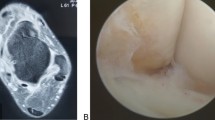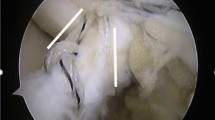Abstract
Purpose
To compare the clinical outcomes of the lasso-loop and simple suture techniques in arthroscopic anterior talofibular ligament (ATFL) repair for the treatment of chronic lateral ankle instability (CLAI).
Methods
From 2018 to 2020, patients with CLAI who underwent arthroscopic ATFL repair using the lasso-loop or simple suture technique were matched 1:1 (arthroscopic lasso-loop [AL] group, n = 29; simple arthroscopic suture [AS] group, n = 29) based on age, sex, affected side, body mass index, and follow-up duration using propensity score matching and retrospectively evaluated. Karlsson score, visual analogue scale (VAS) score, Tegner score, anterior drawer test (ADT) results, complications, patient-reported satisfaction, and magnetic resonance (MR) re-evaluation findings of ATFL quality were used to describe the outcomes.
Results
The patient characteristics or follow-up durations did not significantly differ between the two groups. The Karlsson score, VAS score, and Tegner score improved significantly in both groups after a mean follow-up duration of 29.6 ± 2.8 months. The postoperative clinical scores, ADT results, satisfaction rates, complication rates and MR re-evaluation findings were not significantly different between the two groups at the latest follow-up.
Conclusion
The lasso-loop technique was equivalent to the simple suture technique in arthroscopic ATFL repair for the treatment of CLAI after a minimum follow-up of 2 years, suggesting that the simple suture technique is sufficient for arthroscopic ATFL repair in most patients without the need to add a lasso loop.
Level of evidence
Level III.





Similar content being viewed by others
Data availability
The data that support the findings of this study are available from the corresponding author, ZC, upon reasonable request.
References
Acevedo JI, Mangone PG (2021) Arthroscopic surgical technique for lateral ankle ligament instability. Foot Ankle Clin 26:65–85
Aicale R, Maffulli N (2020) Chronic lateral ankle instability: topical review. Foot Ankle Int 41:1571–1581
Brown AJ, Shimozono Y, Hurley ET, Kennedy JG (2020) Arthroscopic versus open repair of lateral ankle ligament for chronic lateral ankle instability: a meta-analysis. Knee Surg Sports Traumatol Arthrosc 28:1611–1618
Cordier G, Nunes GA, Vega J, Roure F, Dalmau-Pastor M (2021) Connecting fibers between ATFL’s inferior fascicle and CFL transmit tension between both ligaments. Knee Surg Sports Traumatol Arthrosc 29:2511–2516
Drakos M, Hansen O, Kukadia S (2022) Ankle instability. Foot Ankle Clin 27:371–384
Giza E, Shin EC, Wong SE et al (2013) Arthroscopic suture anchor repair of the lateral ligament ankle complex: a cadaveric study. Am J Sports Med 41:2567–2572
Gribble PA, Delahunt E, Bleakley C et al (2013) Selection criteria for patients with chronic ankle instability in controlled research: a position statement of the international ankle Consortium. J Orthop Sports Phys Ther 43:585–591
Guo H, Huang WQ, Lin XJ, Chen BT, Zeng CJ (2020) Validation of a Chinese translation of the identification of functional ankle instability questionnaire. Chin Med J (Engl) 133:2261–2262
Herzog MM, Kerr ZY, Marshall SW, Wikstrom EA (2019) Epidemiology of ankle sprains and chronic ankle instability. J Athl Train 54:603–610
Hunt KJ, Hurwit D (2013) Use of patient-reported outcome measures in foot and ankle research. J Bone Jt Surg Am 95:e118(1-9)
Li H, Hua Y, Li H, Ma K, Li S, Chen S (2017) Activity level and function 2 years after anterior talofibular ligament repair: a comparison between arthroscopic repair and open repair procedures. Am J Sports Med 45:2044–2051
Malinowski K, Paszkowski J, Goralczyk A, Giza E, Hermanowicz K (2020) Arthroscopic anatomic anterior talofibular ligament repair for anterolateral ankle instability. Arthrosc Tech 9:e29–e33
Mederake M, Hofmann UK, Ipach I (2022) Arthroscopic modified Broström operation versus open reconstruction with local periosteal flap in chronic ankle instability. Arch Orthop Trauma Surg 142:3581–3588
Michels F, Pereira H, Calder J et al (2018) Searching for consensus in the approach to patients with chronic lateral ankle instability: ask the expert. Knee Surg Sports Traumatol Arthrosc 26:2095–2102
Nery C, Raduan F, Del Buono A, Asaumi ID, Cohen M, Maffulli N (2011) Arthroscopic-assisted Broström-Gould for chronic ankle instability: a long-term follow-up. Am J Sports Med 39:2381–2388
Nishimura A, Nakazora S, Senga Y et al (2021) Arthroscopic internal brace augmentation with arthroscopic modified Broström operation for chronic ankle instability. Arthrosc Tech 10:e995–e1000
Pacheco J, Guerra-Pinto F, Araujo L et al (2021) Chronic ankle instability has no correlation with the number of ruptured ligaments in severe anterolateral sprain: a systematic review and meta-analysis. Knee Surg Sports Traumatol Arthrosc 29:3512–3524
Pellegrini MJ, Sevillano J, Ortiz C, Giza E, Carcuro G (2019) Knotless modified arthroscopic-Broström technique for ankle instability. Foot Ankle Int 40:475–483
Ponce BA, Hosemann CD, Raghava P, Tate JP, Eberhardt AW, Lafosse L (2011) Biomechanical evaluation of 3 arthroscopic self-cinching stitches for shoulder arthroscopy: the lasso-loop, lasso-mattress, and double-cinch stitches. Am J Sports Med 39:188–194
Samejima Y, Inokuchi R, Iwashita K et al (2021) Arthroscopic ankle lateral ligament repair alone versus arthroscopic ankle lateral ligament repair with reinforcement by inferior extensor retinaculum. Arch Orthop Trauma Surg 141:987–995
Takao M, Inokuchi R, Jujo Y et al (2021) Clinical outcomes of concurrent surgery with weight bearing after modified lasso-loop stitch arthroscopic ankle stabilization. Knee Surg Sports Traumatol Arthrosc 29:2006–2014
Takao M, Matsui K, Stone JW et al (2016) Arthroscopic anterior talofibular ligament repair for lateral instability of the ankle. Knee Surg Sports Traumatol Arthrosc 24:1003–1006
Woo BJ, Lai MC, Koo K (2020) Arthroscopic versus open Broström-Gould repair for chronic ankle instability. Foot Ankle Int 41:647–653
Yeo ED, Park SB, Lee SW et al (2021) Knotless all-inside arthroscopic modified Broström procedure for lateral ankle instability. J Foot Ankle Surg 60:541–547
Zeng G, Hu X, Liu W et al (2020) Open Broström-Gould repair vs arthroscopic anatomical repair of the anterior talofibular ligament for chronic lateral ankle instability. Foot Ankle Int 41:44–49
Zhi X, Zhang Y, Li W et al (2022) Absorbable suture anchor and knotless anchor techniques produced similar outcomes in arthroscopic anterior talofibular ligament repair. Knee Surg Sports Traumatol Arthrosc 30:2158–2165
Funding
This study was supported by President Foundation of The Third Affiliated Hospital of Southern Medical University.
Author information
Authors and Affiliations
Contributions
HG, ZC and GJ conceived the study. BC initiated the study design. All coauthors contributed to the refinement of the study protocol and to the implementation of the study. HG and BC drafted the manuscript. All authors have reviewed and given their final approval of the submitted version.
Corresponding authors
Ethics declarations
Conflict of interest
None.
Ethical approval
This retrospective comparative study was approved by the Ethics Committee of The Third Affiliated Hospital of Southern Medical University (approval number 2022-Lunshen-042).
Informed consent
All participating patients have signed an informed consent form.
Additional information
Publisher's Note
Springer Nature remains neutral with regard to jurisdictional claims in published maps and institutional affiliations.
Rights and permissions
Springer Nature or its licensor (e.g. a society or other partner) holds exclusive rights to this article under a publishing agreement with the author(s) or other rightsholder(s); author self-archiving of the accepted manuscript version of this article is solely governed by the terms of such publishing agreement and applicable law.
About this article
Cite this article
Guo, H., Chen, B., Chen, Z. et al. The lasso-loop technique is equivalent to the simple suture technique in arthroscopic anterior talofibular ligament repair. Knee Surg Sports Traumatol Arthrosc 31, 2174–2182 (2023). https://doi.org/10.1007/s00167-022-07283-x
Received:
Accepted:
Published:
Issue Date:
DOI: https://doi.org/10.1007/s00167-022-07283-x




